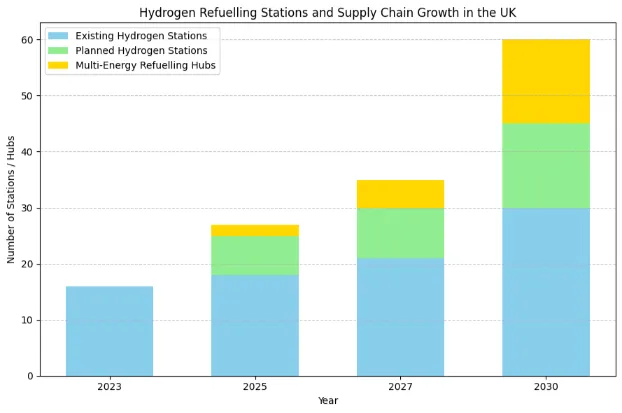
Hydrogen Fuels UK Infrastructure: Building Refueling Stations and Supply Chains
The growth of hydrogen fuels in the UK relies heavily on creating strong refueling infrastructure and efficient supply chains. As the UK speeds up its shift to clean transport, it’s crucial to set up accessible hydrogen refueling stations and dependable production and distribution networks. This support is necessary for the increasing number of vehicles and commercial applications.
Current State of Hydrogen Refueling Infrastructure in the UK
As of early 2025, the UK has a limited but expanding network of hydrogen refueling stations. About 16 operational sites are located in key areas like London, Birmingham, Sheffield, Aberdeen, and South Wales. Many of these stations produce green hydrogen on-site using renewable energy, making the refueling process both sustainable and self-sufficient.
| Country | Number of Stations | Status |
|---|---|---|
| UK | 16 | Expanding |
| Germany | 96 | Market leader |
| China | 400+ | Rapid expansion |
However, the UK’s hydrogen refueling network is still in its early stages compared to other countries. Germany leads Europe with 96 stations, France has 21, and the Netherlands has 14, while China has over 400 stations, with hundreds more being built. The current size of the UK’s network poses challenges for broader hydrogen vehicle adoption, especially for commercial fleets and long-distance transport.
Strategic Approach: Regional Hydrogen Clusters
The UK H2Mobility strategy aims to develop regional hydrogen clusters. These clusters focus on areas where demand from buses, delivery trucks, local rail, and fleet vehicles can support economically viable refueling stations. They act as hubs that grow naturally as the number of vehicles increases. Eventually, they will connect along major roads, creating a nationwide network.
This cluster-based approach is backed by significant government investment and European funding, aiming to establish a scalable and sustainable hydrogen infrastructure.
Major Investments and New Developments
Significant funding and private sector projects are speeding up infrastructure growth:
- Aegis Energy: Secured £100 million from Quinbrook Infrastructure Partners to build 30 multi-energy refueling hubs by 2030. Initial sites will open as early as 2026 in Sheffield, Immingham, Warrington, Corby, and Towcester. These hubs will provide hydrogen along with bio-CNG, HVO, and electric charging, catering to commercial vehicle fleets and addressing the limits of battery electric vehicles for heavy transport.
- Element 2: Won £8 million in government funding to build four new hydrogen refueling stations, including one planned for Teesside Airport, expected to open in 2024.
These investments aim to clear key obstacles like limited refueling options for high-mileage fleets and the lack of home charging for many van drivers. This effort supports the UK’s goal to eliminate fossil-fueled commercial vehicles by 2035-2040.
For more information on UK government hydrogen initiatives, see the official government announcement on hydrogen transport.
Building the Hydrogen Supply Chain
Beyond refueling stations, the hydrogen supply chain includes production, storage, and distribution:
Green Hydrogen Production
Many UK stations create hydrogen on-site through electrolysis powered by renewable energy, ensuring a low-carbon fuel supply. The UK government aims for up to 10GW of new low-carbon hydrogen production capacity by 2030 to meet transport and industrial needs.
Storage and Distribution
Hydrogen’s low density and storage issues call for innovative solutions such as decentralized production, mobile refueling units, and pipeline infrastructure. These strategies help fill gaps in supply and offer flexible refueling options for remote or developing markets.
Challenges and Outlook
Despite progress, challenges remain:
- The current number of public hydrogen refueling stations is not enough for widespread market adoption, especially for passenger vehicles and long-haul trucks.
- Recently, the UK’s hydrogen refueling network has contracted, with closures of stations previously run by Shell and ITM Power. However, new investments and government support are reversing this trend.
- Ensuring the safety, reliability, and compatibility of refueling infrastructure is vital to build trust among consumers and fleet operators.
Learn more about hydrogen technology and its applications from the Institution of Gas Engineers and Managers.
Conclusion
The hydrogen fuels infrastructure in the UK is rapidly changing. The development of strategic regional clusters, multi-energy refueling hubs, and increasing green hydrogen production capacity are creating a backbone for a sustainable hydrogen transport system. Ongoing investment, innovation, and policy backing are crucial to expanding refueling stations and supply chains, enabling hydrogen to play a key role in the UK’s clean transport future.
Hydrogen Energy Case Studies & Resources
Explore these real-world applications and strategic documents about hydrogen technology:
Hydrogen Refuelling Case Studies
Fuel Cell Systems showcases practical implementations of hydrogen refuelling solutions across various industries.
Source: Fuel Cell Systems UKTees Valley Hydrogen Transport Project
A case study on hydrogen-powered transport initiatives in the Tees Valley region of the UK.
Source: CenexHydrogen-Powered HGV Innovation
Case study about an innovative hydrogen-powered heavy goods vehicle developed in Glasgow.
Source: Glasgow City of Science & InnovationUK Hydrogen Strategy
The official UK government publication outlining the national strategy for hydrogen energy development.
Source: UK GovernmentNote: These links are external resources and will take you to third-party websites.